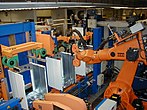Enforcement joining
Clinching ( synonyms : Eckold - pressure joining , clinching or pressing Joining according to any patents holder also Toxen ) is a method for joining sheet metal , tubular and / or profile parts without the use of an additional material. It belongs to the process group joining by forming , since the connection is achieved by forming the material.
The static strengths are in the range from about 2/3 to 1.5 times that of a comparable spot welded joint. The fatigue strength is higher than with spot welded connections due to the lack of notch effect (with non-cutting connections) and the absence of a heat affected zone. Clinching offers great potential, especially when different sheet metal thicknesses (component thicknesses) have to be connected. If the joining direction "thick in thin" is adhered to, static strengths that exceed one and a half times the strength of a spot welded connection are possible. Another advantage is that different types of materials and / or coated sheets can also be joined.
A clinching tool consists of a punch and a die . The sheets to be joined (parts to be joined) are pressed into the die with plastic deformation, similar to deep drawing . A special design of the die creates a shape similar to a push button, which connects the sheets (parts to be joined) with one another in a form-fitting and force-fitting manner. Depending on the system, either a recess in the bottom of a rigid die or the yielding of movable die segments causes the sheets to overlap. A distinction must be made here between the round point, at which the stamp leaves a round, gastight recess (see sectional view), and the rectangular point, at which the connection is cut on two sides and so the gas-tightness cannot be guaranteed. For this purpose, higher-strength materials can also be joined together in this process.
A special form of clinching is hydraulic pressure joining, in which a high-pressure fluid acts as a substitute for a punch.
Process sequence (die with movable die segments)
- Combined sinking and enforcement
- Upsetting and widths
- Filling in the engraving
- Opening the movable die segment
- Lateral flow afterwards
Process sequence (rigid die)
- Combined sinking and enforcement
- Upsetting and widths
- Filling in the upper contour of the engraving
- Filling in the ring canal
- Lateral flow afterwards
use cases
Clinching is often used in automotive manufacturing to join body parts together. The process partially replaces spot welding .
Another focus is the clinching of white goods (refrigerators, washing machines, etc.), because pre-painted sheets that have already been coated by the sheet metal supplier (often the steel manufacturer itself) can be used. The producer of the white goods then saves himself an expensive and time-consuming paint shop. The clinching tools can be adjusted so that the painted surfaces are not damaged.
Another application is the clinching of gas meters. Clinching has the advantage that gas tightness is always achieved, which is not always the case with other joining methods. The testing effort for leak testing can therefore be minimized by means of clinching.
A manufacturer of gas condensing boilers had switched its production to clinching because, among other things, it is much quieter than the previous riveting process. In addition, the tool life is much better.
Clinching is also often used to secure the components with adhesive bonds until the adhesive has cured. This process is called clinch bonding or hybrid joining and is used in bodywork , among other things .
- Product examples
One application of the air-conditioning and ventilation are air ducts .
See also
Web links
- Explanation of the enforcement by the patent owner BTM Company in individual steps and video sequences
- Explanation of the enforcement by the patent owner TOX PRESSOTECHNIK in single steps with pictures
Individual evidence
- ↑ Peter Scharf, Hermann Großberndt and 6 co-authors: Automated assembly with screws . Ed .: Prof Dr.-Ing. Wilfried J. Bartz, DI Elmar Wippler. 2nd Edition. expert Verlag, Renningen-Malmsheim 1994, ISBN 3-8169-1028-9 , p. 184 .








